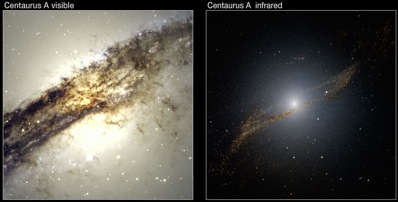
ESO dines out on cannibalistic galaxy
DR EMILY BALDWIN
ASTRONOMY NOW
Posted: November 20, 2009


Using ESO's 3.58-metre New Technology Telescope (NTT) astronomers have penetrated the thick dust lanes of giant galaxy Centaurus A to unveil its 'last meal'.
 This SOFI/NTT image reveals the parallelogram-shaped remains of a smaller galaxy that was gulped down by Centaurus A about 200 to 700 million years ago. The field of view is about 4 x 4 arcminutes. Image: ESO/Y. Beletsky. This SOFI/NTT image reveals the parallelogram-shaped remains of a smaller galaxy that was gulped down by Centaurus A about 200 to 700 million years ago. The field of view is about 4 x 4 arcminutes. Image: ESO/Y. Beletsky.
At a distance of 11 million light years, Centaurus A (also known as NGC 5128) is a giant, elliptical galaxy known to host a supermassive black hole at its core that boasts a mass 50 times that of the one that lies buried in the heart of our own Milky Way Galaxy. Centaurus A's black hole, however, is continuously fed by material falling onto it, making the galaxy one of the brightest known radio sources in the sky.
Centaurus A is banded by a dark dust lane thought to be the remains of an ancient cosmic merger event between the giant elliptical galaxy and a smaller spiral galaxy full of dust. Using the NTT's near-infrared capabilities, astronomers peered through the opaque dust lanes of Centaurus A, unveiling its last meal churning in the belly of this cannibalistic galaxy. The consumption is likely triggering the formation of new stars alongside thousands of resident star clusters.
 Comparison between a visible-light (left; seen with the Wide-Field Imager on the MPG/ESO 2.2-metre telescope) and near-infrared view of Centaurus A (right; obtained with the SOFI instrument on ESO’s New Technology Telescope.) Image: ESO/Y. Beletsky. Comparison between a visible-light (left; seen with the Wide-Field Imager on the MPG/ESO 2.2-metre telescope) and near-infrared view of Centaurus A (right; obtained with the SOFI instrument on ESO’s New Technology Telescope.) Image: ESO/Y. Beletsky.
First glimpses of Centaurus A's 'leftovers' were spotted by ESA's Infrared Space Observatory, revealing a 16,500 light year-wide structure resembling a small barred galaxy. Later observations with NASA's Spitzer Space Telescope resolved the structure into a parallelogram-like shape, which can be explained as the remnant of a gas-rich spiral galaxy falling into an elliptical galaxy and becoming twisted and warped in the process.
The new SOFI images, obtained with the 3.58-metre NTT at ESO’s La Silla Observatory, have provided an even sharper view of the demolition act. Images were obtained by observing at near-infrared wavelengths through three different filters, which were then combined using a new technique to remove the screening effect of the dust. The result is a clear view of the galaxy's core.
“There is a clear ring of stars and clusters hidden behind the dust lanes, and our images provide an unprecedentedly detailed view toward it,” says Jouni Kainulainen, lead author of the paper reporting these results in the journal Astronomy and Astrophysics.
Further analysis will provide important clues on how the merging process occurred and what has been the role of star formation during it. “These are the first steps in the development of a new technique that has the potential to trace giant clouds of gas in other galaxies at high resolution and in a cost-effective way,” says co-author João Alves. “Knowing how these giant clouds form and evolve is to understand how stars form in galaxies.”
The technique will complement the activities of future telescopes like ALMA, the E-ELT and the JWST.
|



